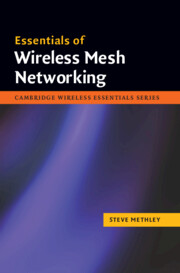Book contents
- Frontmatter
- Contents
- Preface
- Acknowledgements
- 1 Mesh overview and terminology
- 2 Attractive mesh attributes and applications
- 3 Fundamentals of mesh technology
- 4 Mesh capacity, scalability and efficiency – hypothesis testing
- 5 Mesh susceptibility
- 6 Mesh services and quality of service
- 7 Summary of potential mesh pitfalls to avoid
- 8 Appropriate telecommunications applications for mesh
- 9 Successful mesh implementations
- 10 Wireless sensor networks (WSNs) as mesh networks
- Abbreviations
- Selected definitions
- Appendix: Mobility models
- About the author
- Index
- Mesh hints and tips
Appendix: Mobility models
Published online by Cambridge University Press: 01 March 2010
- Frontmatter
- Contents
- Preface
- Acknowledgements
- 1 Mesh overview and terminology
- 2 Attractive mesh attributes and applications
- 3 Fundamentals of mesh technology
- 4 Mesh capacity, scalability and efficiency – hypothesis testing
- 5 Mesh susceptibility
- 6 Mesh services and quality of service
- 7 Summary of potential mesh pitfalls to avoid
- 8 Appropriate telecommunications applications for mesh
- 9 Successful mesh implementations
- 10 Wireless sensor networks (WSNs) as mesh networks
- Abbreviations
- Selected definitions
- Appendix: Mobility models
- About the author
- Index
- Mesh hints and tips
Summary
The aim of using a mobility model is to reflect as accurately as practicable the real conditions themselves. One way to do this is to use motion traces, which are logs of real-life node movements over a representative period of time. There are not many such logs available for use even with established cellular schemes, and none are known to this author which cover mesh environments. The focus then must move to synthetic models. Such a model will deal with a number of nodes and may include parameters such as speed and direction of movement, the ability to pause at some locations and a bound to the model area. The models available are mostly fairly simple to implement, since they are intended for use in simulators where a tractable run time is expected. It is probably the case that present models err on the side of simplicity at the expense of realism. On the other hand, moving too close to the actual environment requires a very specific model – which may then not be adequately representative of all environments. The choice of model is thus a subject which needs to be understood, in order to interpret specific protocol and other simulation results for wider contexts.
Camp et al. [1] review 12 different mobility models which have been applied to mesh simulations at various points in the published literature. Their work is an often quoted indication that the choice of model alone can strongly affect the results when testing the exact same routing protocol. For the purposes of this book three models are noted as being appropriate.
- Type
- Chapter
- Information
- Essentials of Wireless Mesh Networking , pp. 221 - 224Publisher: Cambridge University PressPrint publication year: 2009



